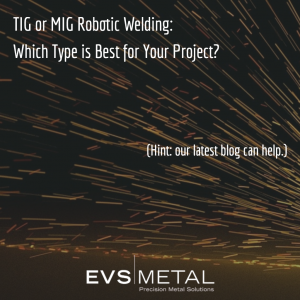Article Revised August 17th, 2022
 Automation is not a new concept in manufacturing; however, the types of automation in use grow more technologically advanced every day. This is certainly the case for robotic welding in metal fabrication environments, although it’s been around for more than 60 years. We covered the basics of robot welding two weeks ago, including its origins and history. This week, we’ll go into more detail about the types of welding that can be done with robots, including a little more about the robots themselves.
Automation is not a new concept in manufacturing; however, the types of automation in use grow more technologically advanced every day. This is certainly the case for robotic welding in metal fabrication environments, although it’s been around for more than 60 years. We covered the basics of robot welding two weeks ago, including its origins and history. This week, we’ll go into more detail about the types of welding that can be done with robots, including a little more about the robots themselves.
Types of Welding Robots
There are a number of different kinds of welding robots, but two, in particular, are the most commonly found in industrial environments: rectilinear and articulating. Rectilinear robots are extremely useful but less flexible than their articulating counterparts because they can only move in line with three axes. Articulating robots, on the other hand, are more complex and more closely mimic the “anatomy” of a human arm and wrist, making them more adaptable (and more expensive!) than other choices.
Types of Robotic Welding
One of the most common applications of robot welding is robotic arc welding. This method involves a power supply creating an electric arc between an electrode and a metal part, generating enough heat to fuse pieces of metal together permanently. Robots can weld in this “arc” pattern by programming the controller directly, utilizing machine vision, or combining the two. Unlike other types of welding, arc welding necessitates the use of a shielding gas to prevent contamination of the workable portion of the weld (the “weld pool”), ensuring that the welds remain uncompromised and retain their structural integrity. Shielding gas also makes cleaning up the welded parts easier once the process has been completed.
Arc welding includes several different subtypes, and for the sake of simplicity, we’ll talk only about two of the most common here — MIG and TIG. The primary differnce between the two is that MIG welding (Metal Inert Gas), also known as GMAW (Gas Metal Arc Welding), utilizes a continuously feeding wire, while TIG (Tungsten Inert Gas), also referred to as GTAW (Gas Tungsten Arc Welding), requires the use of long welding rods that are slowly fed into the weld puddle. However, as you can see in the chart below, both are considered excellent choices, and each has its advantages depending on the application it’s being used for.
| Type | MIG (Metal Inert Gas) | TIG (Tungsten Inert Gas) |
|
Basics |
|
|
| Metals Used |
|
|
|
Advantages |
|
|
Come back next week when we continue our discussion on robotic welding.
Looking for precision sheet metal fabrication and machining services?
EVS Metal is an American precision metal fabricator headquartered in Riverdale, NJ. We utilize the latest technology to cut, bend and finish stand-alone items as well as parts for integration or assembly into more complex products. Our four ISO 9001:2015-certified locations comprise over 250,000 square feet of vertically integrated manufacturing space and feature the most modern equipment available, from robotic welding and laser cutting solutions to automated powder coating lines. We serve a diverse customer base across North America, providing a range of services from quick-turn prototypes to high-volume production runs.
Request a personalized metal fabrication quote online, or call (973) 839-4432 to speak with a specialist today.





